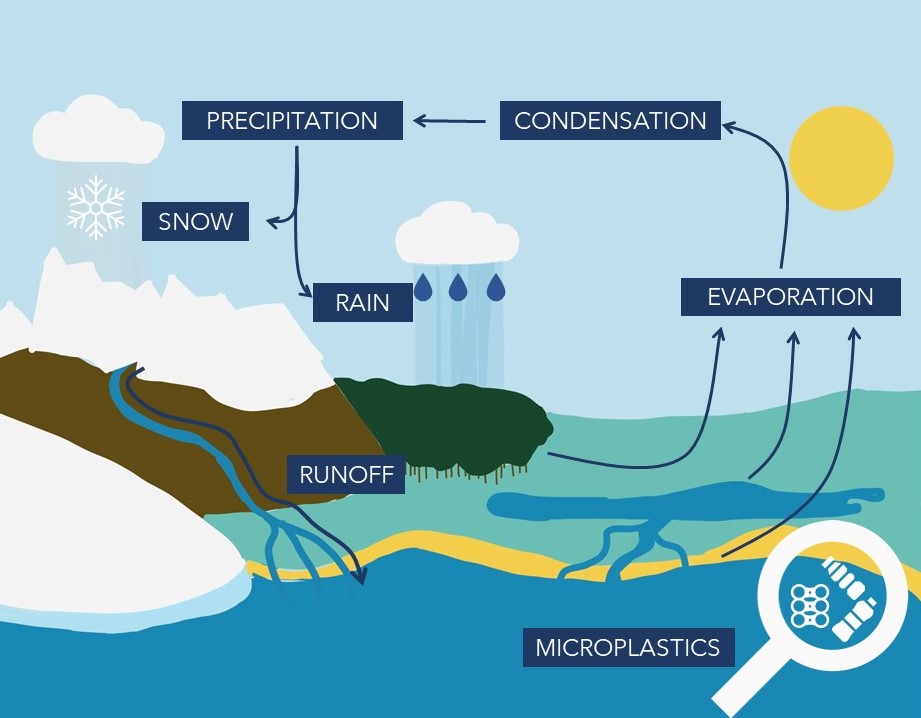 When scientists in Japan collected samples of cloud water from Mount Fuji and Mount Oyama over many months, they were in for a surprise!
When scientists in Japan collected samples of cloud water from Mount Fuji and Mount Oyama over many months, they were in for a surprise!
They discovered particles of nine different plastic polymers and rubber in the samples.
These microplastic particles have molecular structures that could stimulate the cloud to produce rain or ice, and are commonly found in different bodies of water around the world.
How might these tiny particles impact life on Earth? Let’s look a little closer…
How Do Microplastics Get Into the Air?
Plastic fragments smaller than 5mm are called microplastics (MPs). MPs become airborne in various ways and circle the globe in a cycle that is similar to that of the water cycle.
 They enter the atmosphere by several means: 84% of MPs are launched into the air by vehicles, 11% travel by ocean spray and wind currents, and agricultural soil dust contributes 4% to microplastics in the atmosphere.
They enter the atmosphere by several means: 84% of MPs are launched into the air by vehicles, 11% travel by ocean spray and wind currents, and agricultural soil dust contributes 4% to microplastics in the atmosphere.
After becoming airborne, microplastics enter clouds where they can have an effect on cloud behavior and formation.
Plastic normally has “hydrophobic” properties, meaning that it repels water. But after long exposure to ultraviolet (UV) light, degraded particles begin to attract water instead - becoming “hydrophilic”.
These hydrophilic particles are essential to cloud formation because water molecules cannot form large enough droplets to make a cloud without help. They need a core to condense on, and microparticles fit the bill.
MPs can act like ice-nucleating particles (INP), or cloud condensation nuclei (CCN). INP are small airborne fragments that create a foundation for ice crystal formation in clouds. CCN attract water vapor to form cloud droplets.
Because there are so many microplastics in the atmosphere that are hydrophilic, cloud condensation may occur at a more rapid pace. These clouds may be affected in different ways, like how much precipitation they produce, how they reflect the sun, and how long the cloud lasts.
Serious Effects
 Microplastics are small enough to undertake the cycle of precipitation and evaporation along with the water attached to them. These cycles deposit MPs into drinking water, rainfall, and oceans in particular.
Microplastics are small enough to undertake the cycle of precipitation and evaporation along with the water attached to them. These cycles deposit MPs into drinking water, rainfall, and oceans in particular.
If more clouds are formed by airborne MPs, they will reflect higher amounts of sunlight back into the atmosphere. This is a process called indirect radiation effect, and it acts to cool the Earth.
On the other hand, airborne MPs degraded by UV rays in the atmosphere may release greenhouse gasses, which contribute to a warming climate. It is unclear what long-term effects these occurrences will have.
These particles can harm all kinds of living organisms. MPs are showing up inside bodily organs, and affecting hormone levels. Microplastics are extremely toxic, and their presence can lead to various diseases and symptoms.
Moving Ahead
It is important to limit the number of microplastics flowing freely through the air, but there is hope.
Some scientists suggest that only extremely small particles (< 100 nanometers) called nanoplastics, have the potential to affect cloud formation. They propose that the presence of larger MPs in clouds may simply indicate that they are being transported.
More studies are needed to draw definite conclusions about the consequences of these airborne particles. In the meantime, we should use more environmentally friendly materials in our everyday lives to further protect our planet.
Sources: Yale News, Euronews, Mongabay, Earthday.org. NIH.gov











